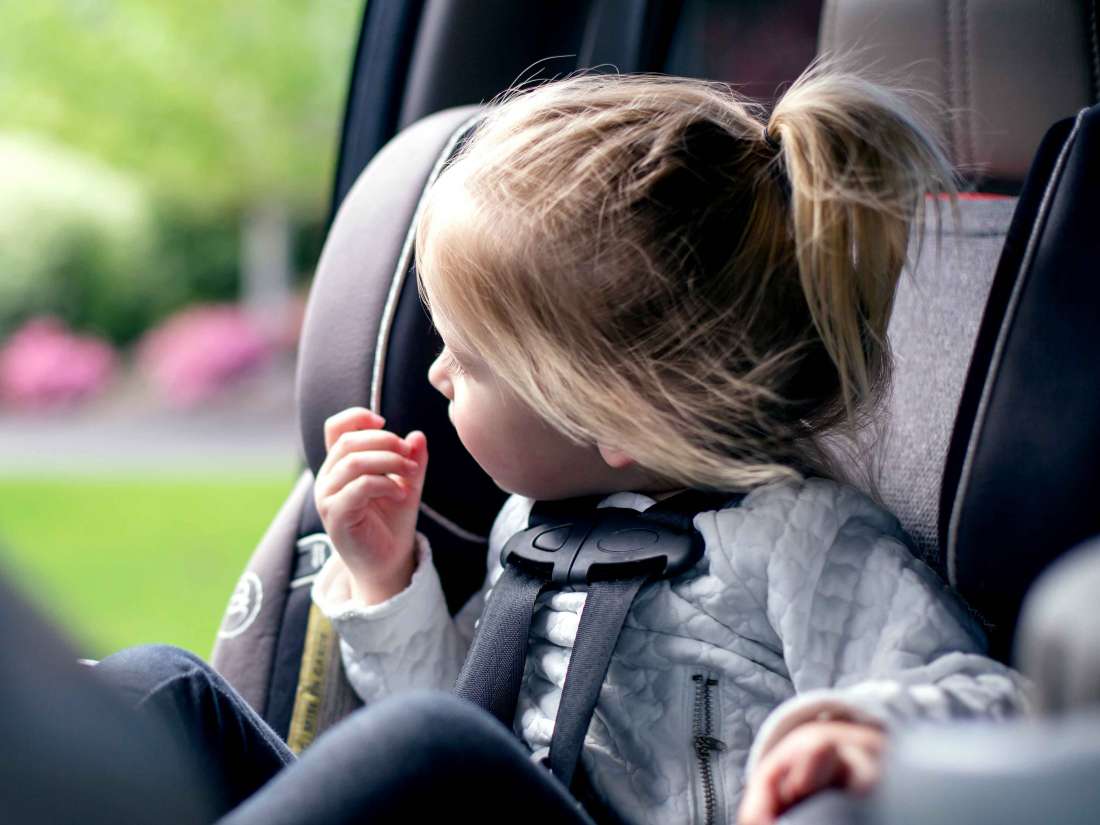If you buy something through a link on this page, we may earn a small commission. How this works. Many organizations recommend that a child only travel in the front seat of a vehicle from the age of 13. The American Academy of Pediatrics (AAP) recommend that all children under the age of 13 sit in the rear seats of vehicles. How they sit in the back seat for example, whether they use a rear-facing seat, a forward-facing seat, or a booster seat will depend on their age, weight, and height. Most cars come equipped with airbags and seat belts. Car manufacturers originally designed these standard safety features to protect adults in the event of a crash. However, they may not prove as useful for protecting a child in the front seat. In this article, we cover what people need to know about child passenger safety. This includes age-specific safety rules, the risks of sitting in the front seat, and some general tips for safe car travel with children.

A child's age, height, and weight determine the most appropriate way for them to sit in a vehicle. Parents and caregivers can keep children safe by buckling them into a seat that is appropriate for their age, height, and weight. Compared with seat belt use alone, car seat use lowers the risk of injury in vehicle crashes by up to 82% in children.
The following sections contain car seat recommendations for children of different age groups.
Birth to 3 years
In previous years, the AAP recommended that children ride in rear-facing car seats until they reached 2 years of age. However, the AAP have since changed this recommendation in response to recent research findings. They now suggest that children ride in a rear-facing car seat until they exceed the seat's weight and height limits. Parents and caregivers should also keep rear-facing car seats in the back seat of the car to prevent airbag injuries. Airbags present a significant risk to children in rear-facing car seats because their heads are much closer to the airbag.
3 to 7 years
Those aged 37 years may exceed the weight and height limits of their rear-facing car seat. If this is the case, they should instead sit in a forward-facing car seat in the back seat of the vehicle. Height and weight recommendations for car seat use vary by state. Weight limits for most seats range from 2065 pounds (lb). Height limits also vary. Generally, children must be at least 4 feet 9 inches tall before they stop using a car seat. The Centers for Disease Control and Prevention (CDC) recommend that children use a forward-facing car seat until they reach at least 5 years of age, however.
8 to 12 years
When a child outgrows their forward-facing car seat, they should use a booster seat. This is to ensure that the car's seat belt fits correctly. The lap belt must lie across the child's upper thighs, and the shoulder belt should fit snuggly against their shoulder and chest. According to the National Safety Council, children should ride in a booster seat until they reach all of the following:
- at least 9 years of age
- 4 feet 9 inches in height
- 80 lb in weight
- State-specific child safety laws
Child passenger safety laws vary by state. People can learn more about their state's child passenger safety law by visiting their state's government website. Alternatively, people can visit the Governors Highway Safety Association page on child passenger safety. Most states permit children over a certain age or size to use an adult seat belt without a car seat or booster seat. Others require booster seats or other child restraint devices for children who have outgrown their car seats. Children who sit in the front seat of a vehicle are at increased risk of injury from airbag deployment. An airbag deploys in under one-twentieth of a second and can cause serious injury. This is why the National Highway Traffic Safety Administration suggest that adults sit at least 10 inches away from the steering wheel. Children tend to be shorter than adults. They may therefore sustain severe head injuries if they are sitting in the front seat of a vehicle when an airbag deploys. Some car manufacturers now use occupant-sensing devices that suppress airbags for infants and children.
Children over 13 years of age who have outgrown a booster seat can sit in the front passenger seat of a car.
- Parents and caregivers can minimize the risk of airbag-related injury by moving the passenger seat as far back as possible.
- People should also try to follow the safety tips below when driving with children in the car:
- Ensure that children use appropriately sized seat belts and safety seats at all times.
- Ensure that children below 13 years of age sit in the back seat.
- Buckle any unused seatbelts to prevent children from playing with them.
- Take care to model safe passenger and driving habits.
- Vehicle crashes present significant risks to children. Parents and caregivers can help keep them safe by using the appropriate car seats and seat belts. Children under the age of 13 should sit in the back seat of a car.
- Parents and caregivers can teach children safe passenger and driving habits by always wearing a seat belt and exercising caution behind the wheel.
According to the CDC, motor vehicle crashes are a leading cause of death among children in the United States. The U.S. Department of Transportation estimate that 3,313 children younger than 13 years of age died while riding in vehicles between 2013 and 2017. Parents and caregivers can sign up to receive safety notifications about their child's car seat at seatcheck.org.
SHOP FOR CAR SEATS
Some of the car seats listed in this article are available to purchase in stores and online:
We picked linked items based on the quality of products, and list the pros and cons of each to help you determine which will work best for you. We partner with some of the companies that sell these products, which means Healthline UK and our partners may receive a portion of revenues if you make a purchase using a link(s) above.








